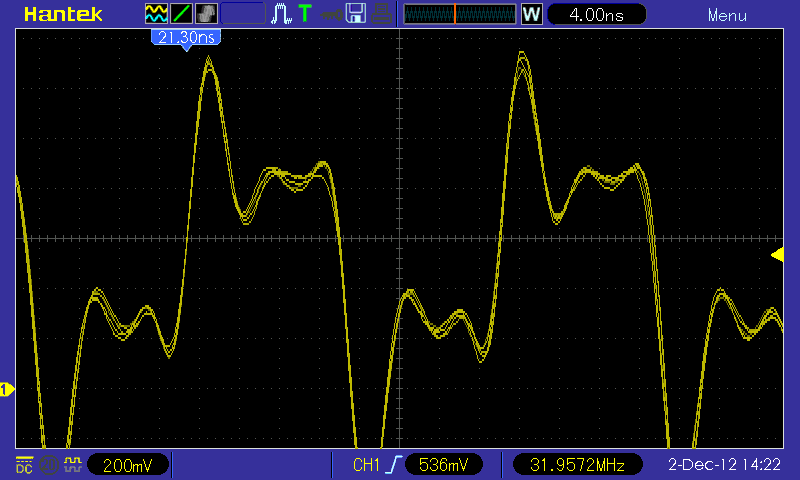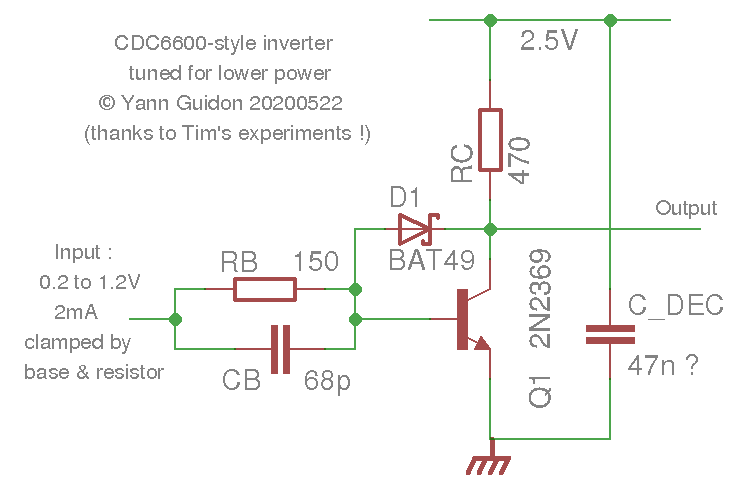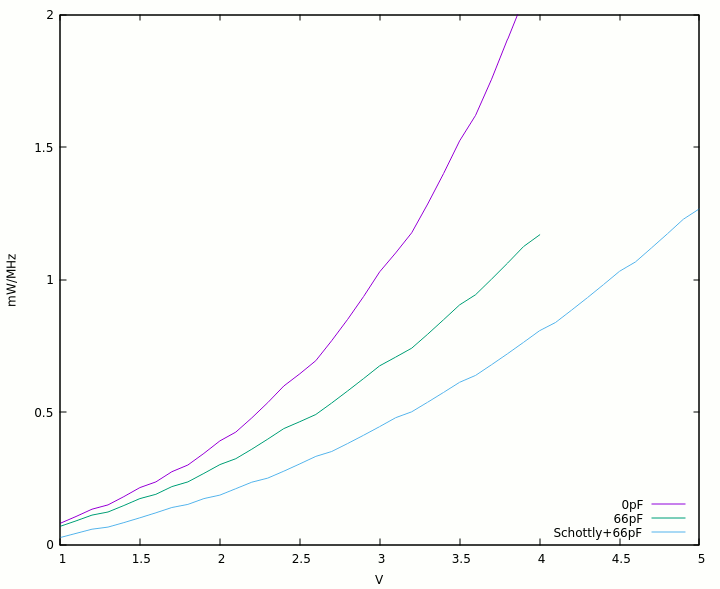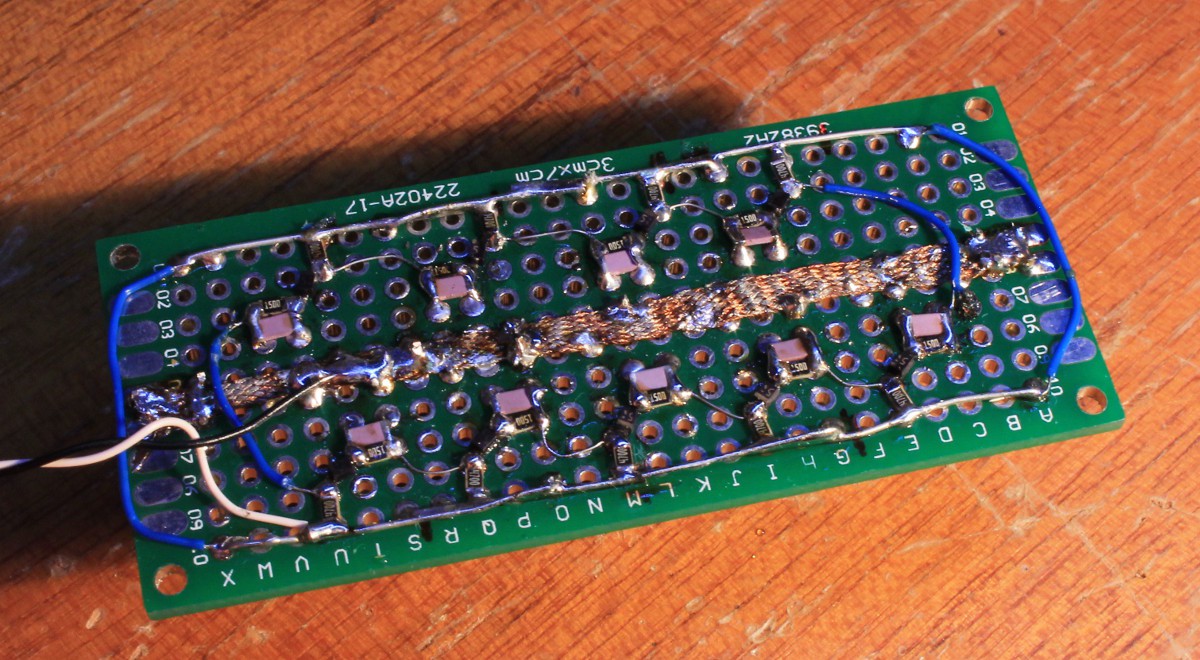In his log Pushing RTL to <2 ns Propagation Delay, Tim alluded that a combination of base capacitor and base-collector diode could reach 2ns of transition time per inverter.
Well, @Tim, it wasn't that hard after all ;-) How about 1.73ns at only 5V ?

OK it's ugly (bad baaaad probing) and the CDC levels are pretty much destroyed...
But it's FAST and even more POWER EFFICIENT !
I get 32MHz at 5.2V and only 77mA, or 44mW per gate, a 4.5× improvement compared to Tim's 200 mW :-)
What's my secret ? Not much, it's explained in the previous logs ;-)
- ample capacitor decoupling
- low Rb (150 Ohms)
- finely chosen Cb (68 pF)
But this log has a newcomer : a Schottky diode. Spoiler alert : I didn't pay much attention, I found 2 reels of SMB and SMA-packaged low voltage diodes in my drawers. I don't even remember where/how/when/why I obtained them but here they are !

This version uses a ROHM RB751V-40 Schottky barrier diode in a tiny tiny package (almost 0603). It's limited to 20mA which matches well because the higher the current, the larger the junction, the more capacitance...
I also have MBR0520 diodes but the higher current rating potentially increases the capacitance, which would create more problems.
The 2N2369A is prevented from "switching hard", which has a welcome effect : less current is drawn ! At 1V the circuit sips only 3mA instead of 6mA... By 2V the difference is mostly erased, though, but at low voltages, that circuit is crazy efficient :-)

Impressive !
Here is the raw data for the summary graphics :
1 6 8.292 9.653 3 12.461
1.1 8 9.191 10.900 5 14.344
1.2 10 9.942 11.955 7 15.976
1.3 11 10.576 12.861 8 17.374
1.4 13 11.140 13.663 10 18.648
1.5 15 11.609 14.363 12 19.720
1.6 16 12.001 14.961 14 20.700
1.7 18 12.344 15.517 16 21.507
1.8 19 12.636 16.029 17 22.351
1.9 21 12.867 16.480 19 23.084
2 23 13.053 16.916 20 23.754
2.1 24 13.182 17.265 22 24.290
2.2 26 13.286 17.634 24 24.875
2.3 28 13.343 17.959 25 25.428
2.4 30 13.364 18.268 27 25.951
2.5 31 13.354 18.559 29 26.436
2.6 32 13.317 18.818 31 26.875
2.7 34 13.253 19.076 32 27.297
2.8 36 13.170 19.307 34 27.702
2.9 38 13.068 19.531 36 28.077
3 40 12.952 19.749 38 28.432
3.1 41 12.826 19.949 40 28.756
3.2 42 12.689 20.140 41 29.063
3.3 44 12.552 20.311 43 29.335
3.4 46 12.408 20.472 45 29.583
3.5 48 12.253 20.630 47 29.832
3.6 49 12.097 20.779 48 30.050
3.7 51 11.938 20.921 50 30.260
3.8 53 11.729 21.060 52 30.467
3.9 55 11.580 21.182 54 30.645
4 56 11.426 21.296 56 30.820
4.1 n n 21.400 57 30.978
4.2 n n 21.500 59 31.126
4.3 n n 21.590 61 31.265
4.4 n n 21.681 63 31.384
4.5 n n 21.766 65 31.507
4.6 n n 21.851 66 31.619
4.7 n n 21.933 68 31.722
4.8 n n 22.010 70 31.824
4.9 n n 22.077 72 31.918
5 n n 22.144 73 31.997
And the gnuplot commands :
set xlabel 'V'
set ylabel 'MHz'
set y2label 'mA'
set xr [1:5]
set yr [6:36]
set y2r [0:90]
set key right bottom
set y2tics 3
plot \
"ringo9v2_0-68pf-RB751.dat" using 1:2 axes x1y2 title "0pF current in mA" w points pt 7, \
"ringo9v2_0-68pf-RB751.dat" using 1:3 title "0pF frequency in MHz" w lines, \
"ringo9v2_0-68pf-RB751.dat" using 1:4 title "66pF frequency in MHz" w lines, \
"ringo9v2_0-68pf-RB751.dat" using 1:5 axes x1y2 title "Schottly+66pF current in mA" w lines, \
"ringo9v2_0-68pf-RB751.dat" using 1:6 title "Schottly+66pF frequency in MHz" w lines
From there we can also plot the power/frequency curves with the following script :
set key right bottom
set xlabel 'V'
set xr [1:5]
set yr [0:2]
set ylabel 'mW/MHz'
plot "ringo9v2_0-68pf-RB751.dat" using 1:(($2*$1/$3))/9 title "0pF" w lines, \
"ringo9v2_0-68pf-RB751.dat" using 1:(($2*$1/$4))/9 title "66pF" w lines, \
"ringo9v2_0-68pf-RB751.dat" using 1:(($5*$1/$6))/9 title "Schottly+66pF" w linesThe result is self-explanatory :-)

These curves were measured on this simple board :


What else is there to say ?
It's not the end of the adventure, of course, because it's only a ring oscillator and the diodes have destroyed the saturating "CDC levels". A clean PCB would help too, but mostly the problems come from multiple inputs driven by one output.
Oh, one last word : the 2N2369 is very cool and easy to use when you understand a few tricks. But there is one design flaw : the can is connected to the collector, not the emitter :-( At least the SMD versions use plastic cases that don't create short circuit hazards.
 Yann Guidon / YGDES
Yann Guidon / YGDES
Discussions
Become a Hackaday.io Member
Create an account to leave a comment. Already have an account? Log In.
Fastest I've measured was gold doped KSP10 with 1N4148 for Baker. Discreet BAT Schottky capacitance worse than recovery time, not same as transistor with integrated Schottky. Clamping pull-up to an intermediate rail also makes even faster. Old scopeshots somewhere I would have to dig for...
Are you sure? yes | no
Dig, please, dig !
Now, the KSP10s are somewhat more expensive than the 2N2369...
Are you sure? yes | no
Great results ! How would it be when the base resistor is zero ohms ? That would make it a DCTL circuit.
Are you sure? yes | no
yes but this works only when one transistor is driven.
Two base loads or more create "balancing" problems due to spec variations and the problem gets more acute as the fanout increases. So it's best to test with the base resistor, even when this is the only load, so the measurements are meaningful and represent real life conditions.
Are you sure? yes | no
Btw, the RINGO5 with parallel capacitor reached 2ns at 39mA/4V=160mW or 26 mW/gate. I should have put the voltage data into my log. Every 100ps improvement beyond that truely escalates power usage, though... It reaches 1.8ns at 6V/61mA
Are you sure? yes | no
With great power come great electricity bills...
Are you sure? yes | no
Now we're waiting for your power/speed curves of your #LED Coupled Logic (LCL) ;-)
Are you sure? yes | no
Coming in a couple of weeks. I am currently designing a PCB.
Are you sure? yes | no
@cpldcpu is a PCB required ? You could solder discrete parts to a proto board, I suppose.
Are you sure? yes | no
@Tim Any update on that front ?
Are you sure? yes | no
uhh.... what exactly? Looks like LCL was completed.
Are you sure? yes | no
@Tim
What about your RINGO5 ? is it logged somewhere I haven't seen ?
Your power/perf figures look interesting, as I try to beat your 26mW/gate with IBM's LVI :-)
Are you sure? yes | no
Its right here:
https://hackaday.io/project/176107/logs
Are you sure? yes | no
@Tim Oh I totally forgot about this one !
That was epic, indeed.
Are you sure? yes | no
Hi Yann, really cool results!
I am almost surprised that the Baker clamps works so well. I was under the impression that there are not mayn suitable Schottky diodes out there, but it looks like you found a fitting one.
Actually I wonder whether it could go even faster when increasing both Rb and Cb, because that would also reduce saturation charge without impacting switching current. I need to do some simulations.
Are you sure? yes | no
yes there is a lot of parameter combinations to experiment !
but the faster you run, the more careful decoupling will be critical...
Are you sure? yes | no